"Strategic triangle" designer Bartini
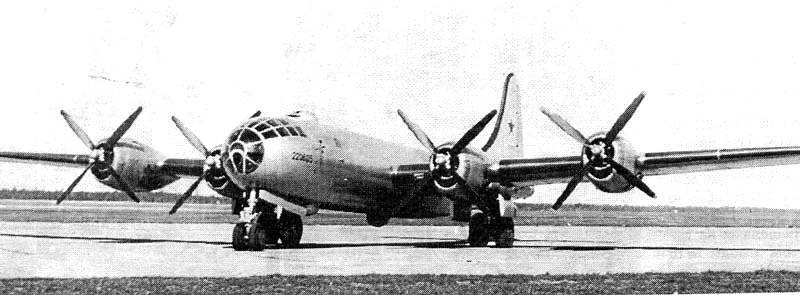
It all started with a preliminary study of the appearance of the aircraft, codenamed T-203. Using only the knowledge of high-speed aerodynamics and mathematics, Bartini quickly calculated several aerodynamic configurations and chose the best one. The intergral tailless tail with a variable wing along the leading edge of the sweep turned out to be optimal. For that time, this aircraft look was too new, so the T-203 remained on paper.
Nevertheless, the developments and calculations on this topic were not in vain. In 1955, Bartini completed the preliminary draft of the supersonic A-55 bomber. This aircraft was largely reminiscent of the T-203, although its design was worked out much better and more detailed. Of particular interest in the new project was the method of application. Bartini decided to make not just a long-range supersonic bomber, but also to provide it with practically unlimited range. For this, the A-55 was supposed to be an amphibious aircraft. Thus, A-55 was able to take off from concrete airfields, go to a given area and, if necessary, get on the water and produce refueling from submarines or surface ships. In addition, the amphibiousness would allow A-55 to be in a certain area for a long time, soaring from which it was possible to strike the target in a matter of minutes. It can be said that if T-203 was just a bold project, then A-55 was very bold. An interesting fact: for the characteristic shape of the aircraft in terms of and A-55, and all subsequent projects of this family received the nickname "strategic triangle".
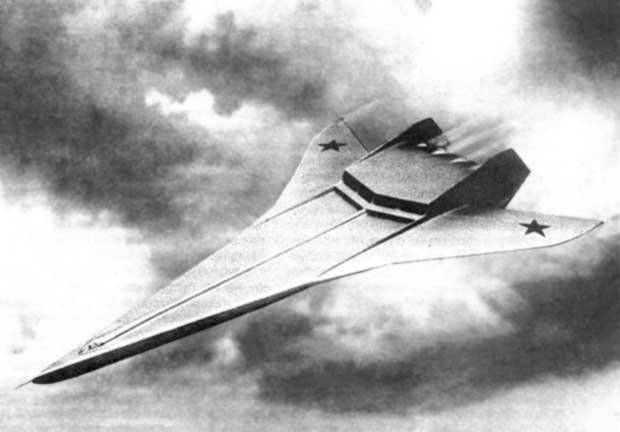
According to Bartini’s calculations, the A-55 design allowed for a maximum speed of about 2500 km / h at a distance of at least ten thousand kilometers. The leadership of the aviation industry, having familiarized themselves with the project, issued its conclusion: the project is certainly interesting and useful, but under current conditions it is not feasible. Nevertheless, thanks to a number of studies on the topic, Bartini was able to defend the project and was entrusted with the task of continuing to work. The entire 56 year went on further purges, consultations with experts from related industries and other studies. In April, the next 1957 of Bartini was transferred from SIBNIA to the OKBS of the Ministry of Aviation Industry. At this point, the project again slightly changes its appearance, and the leading institutes of the industry, TsAGI and CIAM, are involved in the work. In particular, the staff of the Central Aerohydrodynamic Institute explored the characteristics of takeoff and landing on water, as well as the possibilities for a long stay of the aircraft on the surface of the sea or ocean.
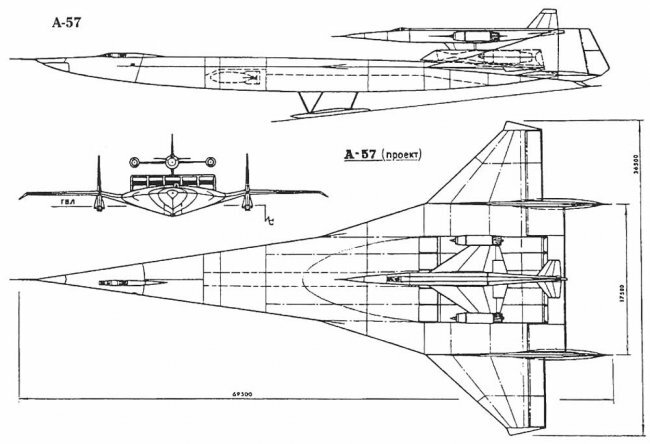
At this stage, the project received a new index - A-57. Now it was a whole complex of aircraft armament, designed to deliver strikes at a great distance from the home airfield. The plane with a delta wing of variable sweep on the leading edge had the design of an integrated circuit. The fuselage and wing mating was done in such a way that there was no noticeable border between them. Amphibiousness of the aircraft was supposed to provide the original ski landing gear. For taxiing on the airfield and take-off, the A-57 aircraft had to be equipped with wheeled carts discharged after separation. The possibility of landing on the water was provided by three skis retractable in flight. The ski landing gear also allowed to land on snow or ice. The implication was that such an opportunity would help to fly not only from continental airfields or the world ocean, but also from icy airfields in the Arctic. As a weapon for the A-57, the RCC intercontinental projectile was developed by designer P. Tsybin. Due to the layout of the internal volumes of the RCC carrier aircraft was to be fixed on the upper side of the A-57.
The crew of three, according to a preliminary draft, had all the means for a long stay on board the aircraft, including in terms of autonomous actions. In addition, it was possible to carry out all technical work from the upper surface of the wing. This design feature provided the opportunity for small repairs by the crew or technicians of tanker ships.
Over the next few years, project A-57 underwent a series of changes of a different nature. For example, the motor nacelle alone was altered three times for different engines. In 1961, the project A-58 was even introduced, according to which the aircraft had a nuclear power plant. Anyway, all the changes in the end did not entail the start of construction of at least a prototype. Project A-57 was extremely complex, expensive and requiring the creation of a mass of new technological processes. In addition, the Bartini aircraft was much more visible to radar stations than the recently created Tu-95. The project has been closed. But on the basis of A-57 another project was created - F-57. From the original aircraft, it differed in size, purpose, and slightly less technological complexity of design.

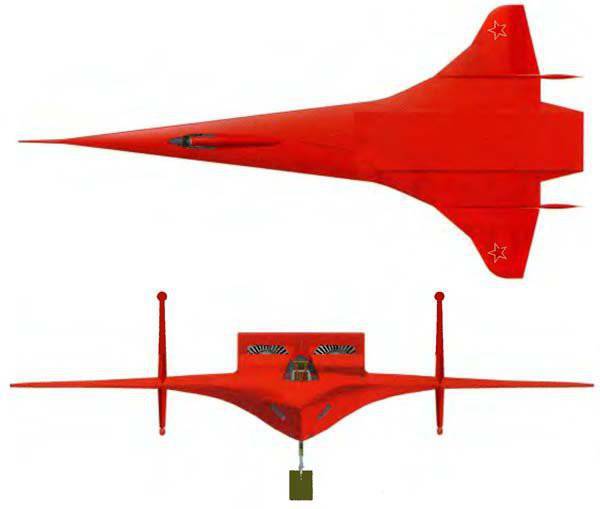
According to the results of a series of consultations, the State Committee for Aviation Engineering under the USSR Council of Ministers (GKAT) decided to continue work in the direction of the super-sound tails of the Bartini structure in an experimental manner. To begin with, they decided to limit themselves to a 20-ton demonstration aircraft. Not wanting to leave his project without any military prospects, the designer began to make not just an experimental aircraft, but a front bomber. Along the way, the aircraft became heavier in relation to the original plans - its take-off weight increased to 25 tons. On the F-57, it was supposed to install two prospective turbojet engines VK-13 with a load of 10 thousand kgf. These engines provided the aircraft with an estimated cruising speed of about 2400-2500 km / h. At the same time, the aerodynamic layout provided good flight characteristics both at supersonic and landing speeds in 260 kilometers per hour. Normal flight range was about 2800 kilometers. From Bartini's previous projects in the field of supersonic bombers, the F-57 received a ski landing gear, albeit its design has been significantly updated. The original scheme of the ski chassis implied one main support located near the center of gravity and two additional ones under the wings. In other words, Bartini equipped his F-57 with a kind of bicycle chassis, but without wheels and without one main support. In the fuselage of the aircraft were provided for the placement of weapons. F-57 could carry from 15 bombs caliber 100 kg to one and a half tons.
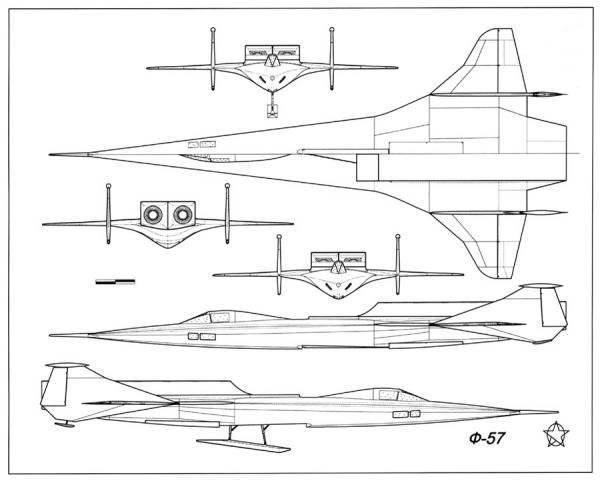
The aviation department officials thoroughly analyzed the project and all related documentation and came to the same conclusion as before. F-57 was a really good bomber, but again there were problems with the technological part of construction. Despite the increased convenience of manufacturing a number of components and assemblies, the F-57 was still unsuitable for mass production. Nevertheless, in GKAT they began to gradually prepare for the beginning of the production of the prototype aircraft. As a site for the construction of the prototype was considered the Moscow plant number XXUMX. While the designers under the leadership of R. Bartini were preparing documents for transfer to the enterprise, new ideas were being developed in the military leadership of the country. At the beginning of the 30s, several changes were made to the structure of the aviation industry and related areas of production. In the context of the F-60 project, they led to the fact that Plant No. XXUMX could not even begin preparations for the assembly of an experienced front-line bomber. Due to the inability to continue work and a slight bias towards the rocket technology, the F-57 project was closed. He was destined to be the last of the "strategic triangle" family. Creating a project A-30 and its "heirs" required a lot of tests, calculations, etc. All of them were not in vain. Most of the knowledge gained was applied in the development of new supersonic bombers, as well as passenger Tu-57.
On the materials of the sites:
http://dogswar.ru/
http://sergib.agava.ru/
http://testpilot.ru/
http://airbase.ru/
Information